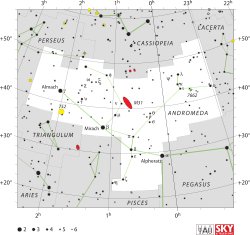Mu Andromedae

| |
| Observation data Epoch J2000 Equinox J2000 | |
|---|---|
| Constellation | Andromeda |
| Right ascension | 00h 56m 45.21211s[1] |
| Declination | +38° 29′ 57.6380″[1] |
| Apparent magnitude (V) | 3.87[2] |
| Characteristics | |
| Spectral type | A5 V[3] |
| U−B color index | +0.15[2] |
| B−V color index | +0.12[2] |
| Astrometry | |
| Radial velocity (Rv) | +7.6[4] km/s |
| Proper motion (μ) | RA: +153.48[1] mas/yr Dec.: +36.49[1] mas/yr |
| Parallax (π) | 25.14 ± 0.86[1] mas |
| Distance | 130 ± 4 ly (40 ± 1 pc) |
| Details | |
| Mass | 2.0[5] M☉ |
| Radius | 2.4[5] R☉ |
| Luminosity | 21[5] L☉ |
| Surface gravity (log g) | 3.99[5] cgs |
| Temperature | 7,959[6] K |
| Metallicity [Fe/H] | +0.03[6] dex |
| Rotational velocity (v sin i) | 75[7] km/s |
| Age | 600[8] Myr |
| Other designations | |
| Database references | |
| SIMBAD | data |
Mu Andromedae (Mu And, μ Andromedae, μ And) is the Bayer designation for a star in the northern constellation of Andromeda. It has an apparent visual magnitude of 3.87,[2] making it readily visible to the naked eye. Based upon parallax measurements, it is approximately 130 light-years (40 parsecs) from Earth.[1] In the constellation, the star is situated about halfway between the bright star Mirach to the southwest and the Andromeda Galaxy (M31) to the northeast.[9]
The spectrum of this star matches a stellar classification of A5 V,[3] indicating that it is an A-type main sequence star. It has double the mass of the Sun and 2.4 times the Sun's radius.[5] The star is radiating about 21[5] times the luminosity of the Sun from its outer envelope at an effective temperature of 7,959 K,[6] giving it the characteristic white glow of an A-type star.[10] It is estimated to be about 600 million years old[8] with a relatively high projected rotational velocity of 75 km/s.[7]
Naming
In Chinese, 奎宿 (Kuí Sù), meaning Legs (asterism), refers to an asterism consisting of μ Andromedae, η Andromedae, 65 Piscium, ζ Andromedae, ε Andromedae, δ Andromedae, π Andromedae, ν Andromedae, β Andromedae, σ Piscium, τ Piscium, 91 Piscium, υ Piscium, φ Piscium, χ Piscium and ψ¹ Piscium. Consequently, μ Andromedae itself is known as 奎宿八 (Kuí Sù bā, English: the Eighth Star of Legs.)[11]
References
- 1 2 3 4 5 6 van Leeuwen, F. (November 2007), "Validation of the new Hipparcos reduction", Astronomy and Astrophysics, 474 (2): 653–664, arXiv:0708.1752
 , Bibcode:2007A&A...474..653V, doi:10.1051/0004-6361:20078357.
, Bibcode:2007A&A...474..653V, doi:10.1051/0004-6361:20078357. - 1 2 3 4 Johnson, H. L.; et al. (1966), "UBVRIJKL photometry of the bright stars", Communications of the Lunar and Planetary Laboratory, 4 (99), Bibcode:1966CoLPL...4...99J.
- 1 2 Cowley, A.; et al. (April 1969), "A study of the bright A stars. I. A catalogue of spectral classifications", Astronomical Journal, 74: 375–406, Bibcode:1969AJ.....74..375C, doi:10.1086/110819.
- ↑ Wilson, R. E. (1953), General Catalogue of Stellar Radial Velocities, Carnegie Institute of Washington D.C., Bibcode:1953GCRV..C......0W.
- 1 2 3 4 5 6 Malagnini, M. L.; Morossi, C. (November 1990), "Accurate absolute luminosities, effective temperatures, radii, masses and surface gravities for a selected sample of field stars", Astronomy and Astrophysics Supplement Series, 85 (3): 1015–1019, Bibcode:1990A&AS...85.1015M.
- 1 2 3 Gardiner, R. B.; Kupka, F.; Smalley, B. (July 1999), "Testing convection theories using Balmer line profiles of A, F, and G stars", Astronomy and Astrophysics, 347: 876–890, Bibcode:1999A&A...347..876G.
- 1 2 Royer, F.; Zorec, J.; Gómez, A. E. (February 2007), "Rotational velocities of A-type stars. III. Velocity distributions", Astronomy and Astrophysics, 463 (2): 671–682, arXiv:astro-ph/0610785
 , Bibcode:2007A&A...463..671R, doi:10.1051/0004-6361:20065224.
, Bibcode:2007A&A...463..671R, doi:10.1051/0004-6361:20065224. - 1 2 Rieke, G. H.; et al. (February 2005), "Decay of Planetary Debris Disks", The Astrophysical Journal, 620 (2): 1010–1026, Bibcode:2005ApJ...620.1010R, doi:10.1086/426937.
- ↑ Reddy, Francis (2011), Celestial Delights: The Best Astronomical Events Through 2020 (3rd ed.), Springer, p. 236, ISBN 1461406099.
- ↑ "The Colour of Stars", Australia Telescope, Outreach and Education, Commonwealth Scientific and Industrial Research Organisation, December 21, 2004, retrieved 2012-01-16.
- ↑ (Chinese) AEEA (Activities of Exhibition and Education in Astronomy) 天文教育資訊網 2006 年 5 月 19 日